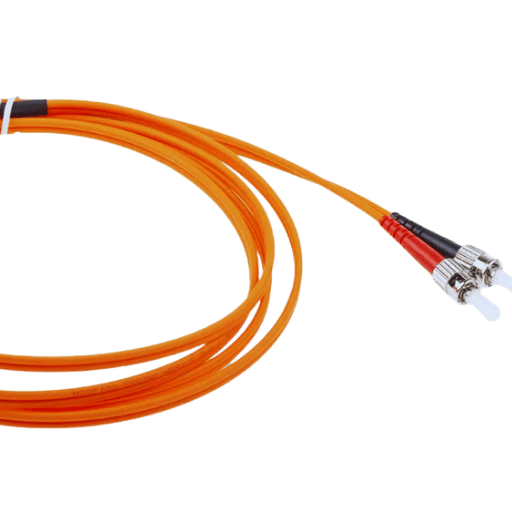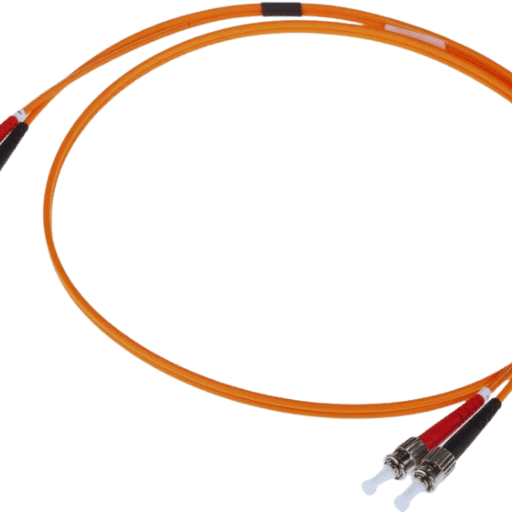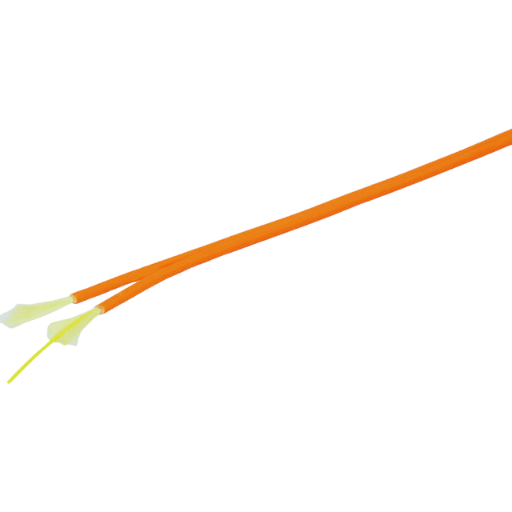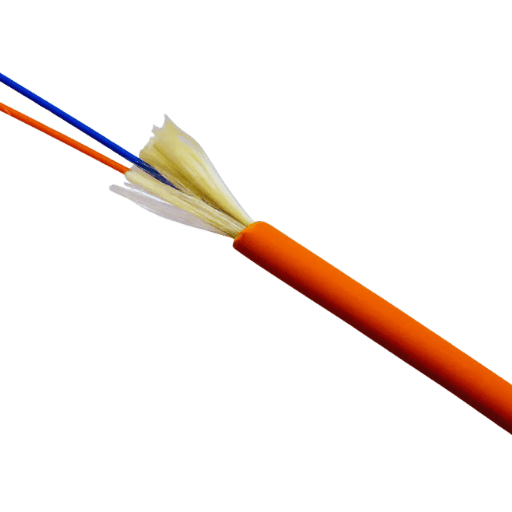Today’s world of telecommunication and transmission of data has grown rapidly with the advent of fiber optics as the fastest means of connectivity. Of all the varieties of fiber optic cables, the orange fiber optic cable is best suited for various reasons. The purpose of the current work may be to provide a detailed description of orange fiber optic cables, their construction, and their advantages in relation to communication network infrastructure development. This article is designed for both practitioners and beginners and focuses on technical parameters, as well as the installation and application of cables in different environments. If you plan to use it in a business system or just want to know more about the technology, this article will help you increase your awareness of orange fiber optic cables.

Orange fiber optic cable is an orange colored extremely pliable compact cable predominantly used for short-haul communication that is an integral part of an optical fiber framework which transmits multimode fibers. Such cables are primarily employed within data centers or within a region between the buildings on a campus. They allow the transmission of data at high bandwidths but only within moderate distances, which makes them suitable for local area networks (LANs), for example. The significance of color coding when installing and maintaining the cable is that it eliminates confusion over the type and application of the cables.
Fiber optic cables constitute the backbone of contemporary telecommunication systems and data networks. They operate by sending light signals through threads of glass or plastic and, can transfer data at high speed over long distances with negligible loss of signal quality. A fiber optic cable is constituted of four basic components which are the core, cladding, buffer coating and outer jacket.
These parts combined offer a significant advantage over standard copper wiring in such areas as increased bandwidth, extended range, and resistance to electromagnetic disruption. The efficiency of fiber optics is also evidenced by their speed, with maximum speeds being able to register as high as several terabits per second, making them essential in high-speed internet, cable television, and telecommunications systems.
Taka is now the country especially overseeing Eastern Africa in Tanzania, the development of infrastructure in communication networks, let alone 4G. Now, having said that, on another action web, in Orange’s case, it had been made to retain multiline Fiber. But definitely, in our case, what is also important are actually the points that you have wads HCI well trained in all in shaping Sensama to size much Les at that time. So in this outlook we feel and we believe that we will be able to win the competitive advantage over other players in the region. Any changes with regards to the wound of any given network to clients ultimately make it substantially low for them. As far as I understand, one of our most critical importance is assistance over in throughout the Far East.
Many companies agree that the color orange should be used for multimode cables as it has become a standard in the industry. This standard is in place because capitalizing on color codes would make the distinction of multimode cables from their singlemode counterparts that are usually yellow. With the application of orange, installation and maintenance are made easier as it eliminates guesswork through visual cues, enhancing efficiency in network management. Such an arrangement applied in data centers would also make it easier to manage these networks by minimizing the guesswork when troubleshooting or making modifications. The application of orange on fiber optic cables is driven by the need for uniformity, security, and easy navigation for the very complicated areas of telecommunications systems.

Multimode fiber optics work by allowing the transmission of light through a greater core diameter, which is generally about 50 to 62.5 micrometers. This makes it possible to transmit multiple wavelengths or modes at the same time, which facilitates the transfer of large amounts of data at shorter distances. However, the different modes also cause modal dispersion, which leads to transmission loss, thereby preventing one from efficiently seeking out longer distances than can be done in a single-mode fiber. In contrast, multimode fibers are most suitable for systems requiring high bandwidth over short distances, such as data centers.
OM1 Fiber Optic Cables: An OM1 cabling has a core diameter of 62.5 micrometers, which enables such cables to transmit light in may forms across the distance. Such cables form the core of short-range communication as they can achieve data rates to a maximum of 1 gigabit per second for a distance of 275m using LED light sources. The OM1 fibers found great use in networking applications as their AM capacity was within the limits of practically any application in its time. However, as technology has evolved and newer standards have been set, one finds OM1 wires rather inefficient when considering data centers requiring high data transfer rates along with long-distance interconnections.
OM2 Fiber Optic Cables: OM1 Wires are now being replaced by OM2 wires as the later wires have slight modifications and a core diameter of 50 micrometers. With a reduced core size, the modal dispersion is now less and thus can perform better over larger distances and with the use of higher bandwidth. OM2 fibers allow a transmission rate of 1 gigabit per second over 550 meters and 10 gigabits for the first 82 meters when using Aussie laser technologies. The enhancement from OM1 to OM2 wires increases data transfer, making them more suitable for the data degree places.
Choosing between OM1 and OM2 fibers for a given application requires consideration of the data rates and ranges needed, along with the logistical aspects of installation and changes in network needs. With the growth and increasing demands placed on network infrastructure, the decision between these types of cables becomes important in maintaining the effective communication of data.

These specifications highlight the basic design and operating characteristics of the OM1 fiber optic cable and the reasons for their use in legacy optical networks that do not impose high data transfer requirements.
Due to their design, OM1 fiber optic cables have a number of characteristics that limit their usage in applications with low data transfer rates and transmission distance. They are particularly common in legacy LANs as well as data communication systems where the needs for performance do not go beyond that of newer fiber standards. At a lower business cost, OM1 cables are suitable for interconnections within enterprise settings such as campuses and data centers which are geared for one Gigabit over short distances. Moreover, these cables are frequently utilized for video conferencing and other multimedia communications in the old networks where the bandwidth requirements aren’t as strict compared to new-age high-end networks.

Patch cables, also referred to as fiber jumpers, links devices and equipment together on a fiber optic network. The geometry and the type of patch cable used greatly affect the performance and ease of integration of a particular network. In this case we look at the LC to LC and SC patch cables.
Cables LC to LC:
Connectors Cables SC:
Knowing these technical parameters enables IT network design and network implementation engineers to choose the required patch cable type according to the particular needs of the network with regard on its data transmission and broader network reliability.
The cable jacket type has a material composition that has major effects on the performance, durability, and safety of network cabling. The most popular polymer for the outer sheath of cables is polyvinyl chloride (PVC). This polymer is cheaper than other materials, easy to use, and self-extinguished which makes it most preferable for many indoor applications. There are, however, applications that require more stringent requirements in terms of fire safety and smoke emission factors, and for such applications, low-smoke zero halogen (LSZH) materials are used. LSZH materials also help to reduce the risk of fire as it does not release halogenated gases upon combustion. Furthermore, rubberized thermoplastics (TPE) are ideal materials for industrial use because they are great when it comes to chemicals and temperature. Therefore, when selecting the materials to use for the cable jackets the environmental factors, safety, and even network requirements should be considered in order to ensure effective and legal compliance.
Duplex patch cables are an indispensable component of today’s network architecture as they make it possible for devices to communicate with each other in both directions. The construction comprises two fiber optics or wires and a common sheath, which makes it possible to send and receive signals simultaneously and hence improves the data transfer rate. Compared to half-duplex which transmits OR receives data at any one time, full-duplex communication offers lower latency and has a higher rate of throughput. Duplex cables are also used in copper and fiber optic systems such as Ethernet networks, which ensure high-bandwidth operations with great reliability. The use of this type of configuration is important in maintaining network efficiency and reducing data traffic congestion.

Client reviews are of particular interest when analyzing fiber optic products as they provide information on how the products perform and how satisfied users are. Such assessments indicate persistent problems or appreciation of certain characteristics and, hence, buyers’ decisions. Reviews can also point out how reliable a given product is, how easy it is to install it, or if the vendor is trustworthy, which can help future customers reduce their risks and make decisions that meet the network requirements. A reliable method of ensuring the accuracy and relevance of customers’ feedback is by addressing concerns from purchasers who have been verified, thereby improving the general process of determining the best fiber optic solutions.
Consolidated inputs from the different users indicate these important features, thus providing potential users with a well-rounded view of multimode fiber in terms of its performance and use in networks with high bandwidth requirements.
A: Orange Fiber Optic Cable is characterized as a multimode fiber optic cable which is used in networks and data communication. The color is typically linked to the multimode OM1 smallest fiber optic patch cords that are employed for short distance data uses.
A: A multimode OM1 fiber optic patch cable has diameter of its core equal to 62.5 micron and this makes it have wide light acceptance angle and several modes of light can travel. This way, it can be used for short bursts of information transfer but single mode ones are for long distance transmission.
A: The term ‘riser’ indicates that the cable can be used in the vertical spaces that separate floors of a building. This means this cable complies with several fire resistance requirements designed to stop flames from traveling up a riser space.
A: An adapter has the ability to join together two pieces of fiber. Adapters ensure the fibrous ends are well aligned so that the two faced ends will not hinder efficient data transfer. SC UPC adapters are among the most widely used types of adapters in networks because they are known to have low insertion loss and high precision.
A: ‘Aqua’ is a color coding that is conventionally associated with OM3 multimode fiber optic cables, which are meant for delivering a data transfer of 10 Gb over a longer distance as compared to OM1 cables.
A: ’LSZH’ is Low Smoke Zero Halogen. These cables with LSZH along the cover produce very minimal smoke and no halogens during combustion at very high heat, which makes them ideal for use in regions with very poor circulation.
A: ‘SC UPC’ is indicated as a type of fiber optic connector. ‘SC’ refers to Subscriber Connector, also Square Connector, while ‘UPC’ connotes Ultra Physical contact. It has been further established that these types of connectors perform reliably even in applications that require high-density populations.
A: the so-called ‘corn’ color is not necessarily a colour coding system that is used with cable in the industry of fiber optic. The cables tend to be color-coded in yellow, orange, aqua, and other colors that represent single-mode or multimode types, with some exceptions. It’s advisable to look into product descriptions for more information.
A: Broadly speaking, multi-mode fiber optic cable bandwidth is determined by the core diameter as well as the mode of transmission. A classic example would be an OM3 cable with a 50-micron core, which can allow a maximum of 10 gigabits per second over short ranges.
A: In any computer or IP network, fiber optic patch cables are very important as they connect different components of the network and transmit data at an acceptable speed and with a high degree of reliability. They are available in different varieties, such as multimode and single mode, to suit different network specifications.